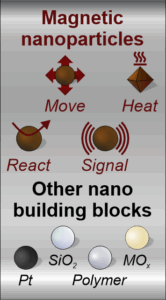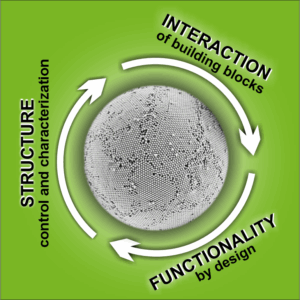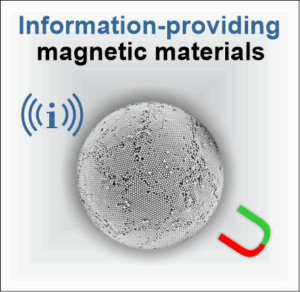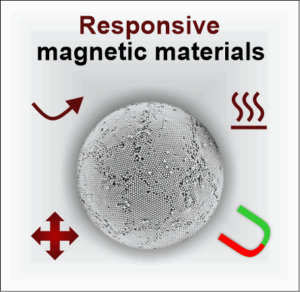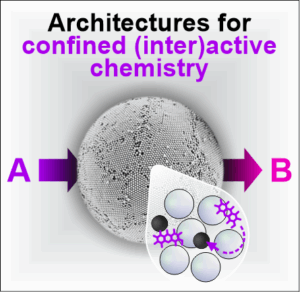Research
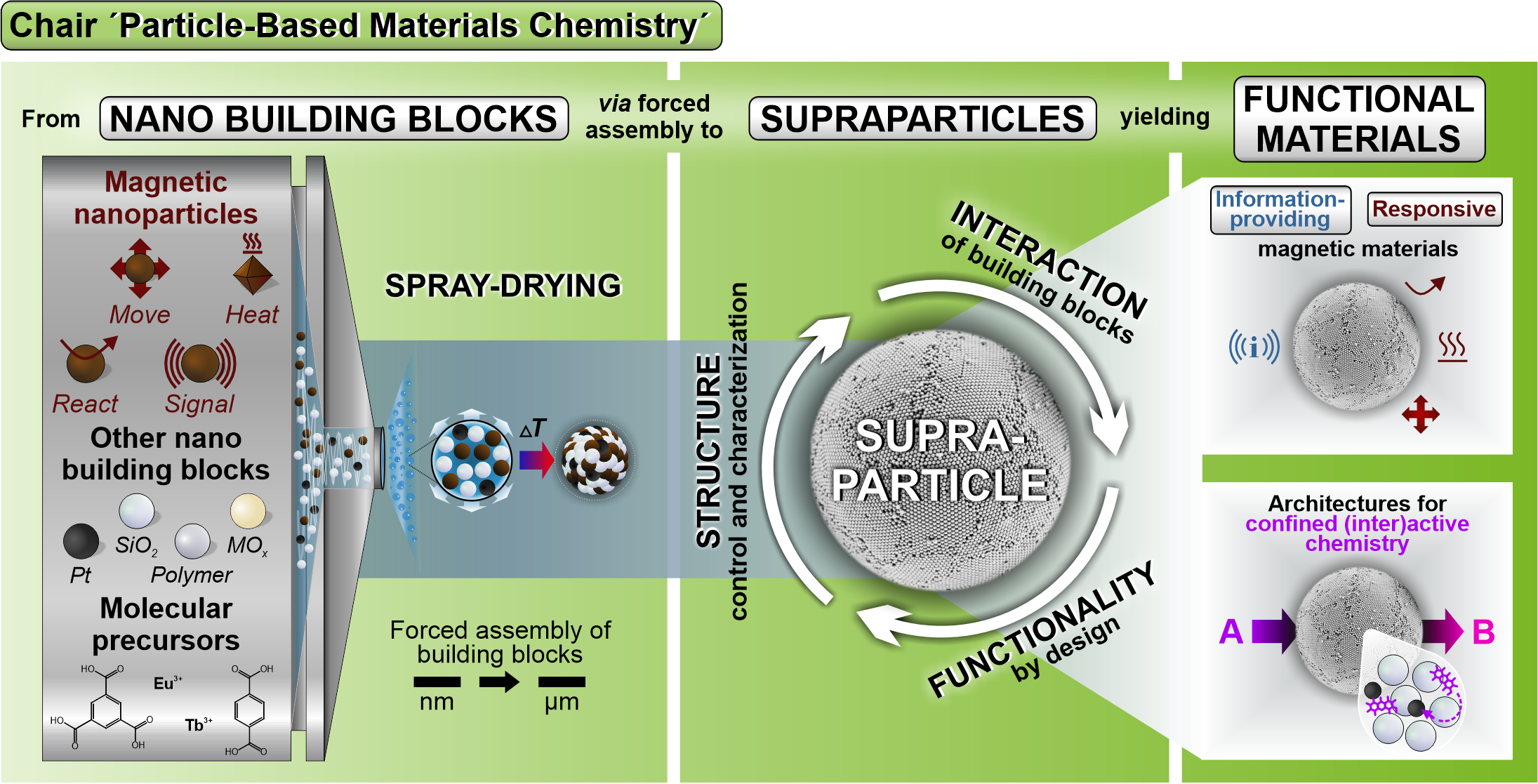
Chair ‘Particle-Based Materials Chemistry’
At the Chair ‘Particle-Based Materials Chemistry’, we design highly functional supraparticles, i.e., particles of a few µm in size that are composed of nanoparticle (and molecular) building blocks.
These complex entities are achieved via forced assembly of the (nano) building blocks, mainly by using the technique of spray-drying.
We study how structure, besides (multimaterial) composition, of such supraparticles affects the interaction among the building blocks of these entities and how this leads to unique functionalities.
A first direction in which we harness this knowledge is the field of magnetic materials, where we aim to realize information-providing or magnetically responsive systems. Here, we focus on iron oxide-based systems and pioneer techniques such as magnetic particle spectroscopy (MPS) to gain information from magnetic materials or induction heating to trigger a response or reaction magnetically.
A second direction, we are interested in, deals with designing architectures that enable confined (inter)active chemistry. There, we try to develop supraparticles in which chemistry is given a home in confinement and can actively run, i.e., we try to turn the supraparticles into little active, reactive and interactive units.
Our research fields in focus:
Size, shape and composition determine the ultimate properties of nanoparticles. Chemical synthesis control enables tailoring these. We synthesize and surface functionalize nanoparticles by means of bottom-up wet chemistry and subsequently use these as building blocks to assemble functional supraparticles. Our focus is on magnetic nanoparticles.
Selected publications:
, Schötz S., Stockinger N., Wintzheimer S., Mandel K., Libuda J., Retzer T.
Supraparticles for naked-eye H2 indication and monitoring: improving performance by variation of the catalyst nanoparticles
In: The Journal of Chemical Physics (2023)
DOI: 10.1063/5.0135130
, Mandel K., Löbmann P.
The Significant Influence of the pH Value on Citrate Coordination upon Modification of Superparamagnetic Iron Oxide Nanoparticles
In: Particle and Particle Systems Characterization (2022)
DOI: 10.1002/ppsc.202100279
, ,
Overcoming the Inhibition Effects of Citrate: Precipitation of Ferromagnetic Magnetite Nanoparticles with Tunable Morphology, Magnetic Properties and Surface Charge via Ferrous Citrate Oxidation
In: Particle and Particle Systems Characterization (2021)
DOI: 10.1002/ppsc.202100098
, ,
Oxidative Precipitation as a Versatile Method to Obtain Ferromagnetic Fe3O4 Nano- and Mesocrystals Adjustable in Morphology and Magnetic Properties
In: Particle & Particle Systems Characterization (2021)
DOI: 10.1002/ppsc.202000307
Upon droplet evaporation, using the tool spray-drying, forced assembly of nano building blocks to supraparticles is possible. Furthermore, via this method, also molecular precursors and molecules can be joined, i.e., we can also perform “chemistry in a droplet”.
We study how we can control structure upon supraparticle formation and how the obtained structure, besides composition, of such supraparticles affects the interaction among the building blocks of these entities and how this leads to unique functionalities.
Selected publications:
Zhou H., Groppe P., Zimmermann T., Wintzheimer S., Mandel K.
Influence of cation concentration and valence on the structure and texture of spray-dried supraparticles from colloidal silica dispersions
In: Journal of Colloid and Interface Science (2024)
DOI: 10.1016/j.jcis.2023.12.051
, Luthardt L., Cao K.L.A., Imaz I., Maspoch D., Ogi T., Bück A., Debecker D.P., Faustini M., Mandel K.
Multifunctional, hybrid materials design via spray-drying: much more than just drying
In: Advanced Materials (2023)
DOI: 10.1002/adma.202306648
, Bleyer G., Endres J., Prieschl J., Vogel N., Wintzheimer S., Mandel K.
Spray-dried photonic balls with a disordered/ordered hybrid structure for shear stress indication
In: Small (2022)
DOI: 10.1002/smll.202203068
, Granath T., Seufert M. T., Kasper T., Müller-Buschbaum K., Mandel K.
Luminescent magnets: hybrid supraparticles of a lanthanide-based MOF and ferromagnetic iron oxide by assembly in a droplet via spray-drying
In: Journal of Materials Chemistry C (2022)
DOI: 10.1039/D1TC04867H
Müssig S., Koch V. M., Cuadrado C. C., Bachmann J., Thommes M., Barr M. K. S., Mandel K.
Spray-Drying and Atomic Layer Deposition: Complementary Tools toward Fully Orthogonal Control of Bulk Composition and Surface Identity of Multifunctional Supraparticles
In: Small Methods (2021)
DOI: 10.1002/smtd.202101296
We work on exploiting the complex interactions among building blocks in supraparticles in a way that we can get information from these interactions. We pioneer magnetic particle spectroscopy (MPS) to unravel information on magnetic interactions within supraparticles. With the goal of deciphering the quite complex signals we obtain with this relatively simple technique, we establish magnetic supraparticles as information-providers within materials, being able to record and report what is going on in objects we cannot look into with other methods. Furthermore, such magnetic supraparticles could for instance also serve as markers / ID-providers in materials to enable material passports.
Selected publications:
Müssig S., Wolf A., Kämäräinen T., Mandel K.
Information-providing magnetic supraparticles: particle designs to record environmental stimuli with readout by magnetic particle spectroscopy
In: Accounts of Materials Research (2025)
DOI: 10.1021/accountsmr.5c00027
Wolf A., Heinlein M., Kent N., Müssig S., Mandel K.
Bulk magnetic properties arise from micron-sized supraparticle interactions and can be modified on the nanoscale
In: Small (2025)
DOI: 10.1002/smll.202412311
Wolf A., Sauer J., Hurle K., Müssig S. and Mandel K.
Magnetic supraparticles capable of recording high temperature events
In: Advanced Funtional Materials (2024)
DOI: 10.1002/adfm.202316212
Reichstein J., Müssig S., Bauer H., Wintzheimer S., Mandel K.
Recording Temperature with Magnetic Supraparticles
In: Advanced Materials (2022)
DOI: 10.1002/adma.202202683
Müssig S., Reichstein J., Prieschl J., Wintzheimer S., Mandel K.
A Single Magnetic Particle with Nearly Unlimited Encoding Options
In: Small (2021)
DOI: 10.1002/smll.202101588
Supraparticles with magnetic building blocks can be magnetically, i.e., remotely, moved or heated. This we exploit to design responsive systems that we can trigger via a magnetic field. Current examples that we research are debonding on demand or enhanced catalysis.
Selected publications:
Raczka T., Groppe P., Hurle K., Moritz M.S., Papp C., Mandel K., Wintzheimer S.
Thermite Reactions within Liquid Gallium/Iron Oxide Supraparticles Triggered Via Induction Heating
In: ACS Applied Nano Materials (2025)
DOI: 10.1021/acsanm.5c01171
Luthardt L., Raczka T., Hurle K., Müssig S., Mandel K.
Customizable induction heating profiles: from tailored colloidally stable nanoparticles towards multi-stage heatable supraparticles
In: Advanced Functional Materials (2024)
DOI: 10.1002/adfm.202412296
Schörner M., Solymosi T., Raczka T., Nathrath P., Johner N.P., Zimmermann T., Mandel K., Wasserscheid P., Wintzheimer S., Schühle P.
Inductively heatable catalytic materials for the dehydrogenation of the liquid organic hydrogen carrier (LOHC) perhydro dibenzyltoluene
In: Catalysis Science & Eingineering (2024)
DOI: 10.1039/d4cy00272e
Reichstein J., Raczka T., Stauch C., Schug B., Müssig S., Mandel K.,
Multifunctional Polymer Composites for Automatable Induction Heating with Subsequent Temperature Verification
In: Advanced Engineering Materials (2024)
DOI: 10.1002/adem.202400744
Raczka T., Wolf A., Reichstein J., Stauch C., Schug B., Müssig S., Mandel K.
Influence of magnetic interactions in iron oxide nanoparticle polymer composites on magnetism and induction heating
In: Journal of Magnetism and Magnetic Materials (2024)
DOI: 10.1016/j.jmmm.2024.172042
We consider supraparticles as a little chemical eco-system. The designable pores can be a “home for molecules”. This enables bridging molecular and nanoparticle chemistry all together in one system. Ultimately, we aim at enabling active, reactive and interactive chemistry in the confinement of a supraparticle and try to exploit this intriguing approach to design new energy, catalyst, sensor and indicator materials.
Selected publications:
, Müller V., Will J., Zhou X., Zhang K., Moritz M.S., Papp C., Libuda J., Retzer T., Spiecker E., Bachmann J., , Wintzheimer S.
Atomic Layer Deposition on Spray-dried Supraparticles to Rationally Design Catalysts with Ultralow Noble Metal Loadings
In: Chemistry of Materials (2025)
DOI: 10.1021/acs.chemmater.4c03429
Zink A., Reichstein J., Ruhland N., Stpckinger N., Morozov B.S., Cuadrado Collados C., Thommes M., Kataev E.A., Wintzheimer S., Mandel K.
Mesoporous supraparticles with a tailored solid-liquid-gas interface for visual indication of H2 gas and NH3 vapour
In: Chemical Communications (2024)
DOI: 10.1039/D4CC01247J
Reichstein J., Groppe P., Stockinger N., Cuadrado Collados C., Thommes M., Wintzheimer S., Mandel K.
Safety Through Visibility: Tracing Hydrogen in Colors with Highly Customizable and Flexibly Applicable Supraparticle Additives
In: Advanced Materials Technologies (2024)
DOI: 10.1002/admt.202400441
Reichstein J., Luthardt L., Martello V.G., Pianetti A., Wintzheimer S., Mandel K.
Modulating the Microenvironment of Coumarin Dyes within Multihierarchical Supraparticles: En Route Toward Versatile Luminescent Dual-Threshold Temperature Indicators with Ratiometric Readout
In: Advanced Optical Materials (2024)
DOI: 10.1002/adom.202303346
Reichstein J., Müssig S., Wintzheimer S., Mandel K.
Communicating supraparticles to enable perceptual, information-providing matter
In: Advanced Materials (2023)
DOI: 10.1002/adma.202306728


